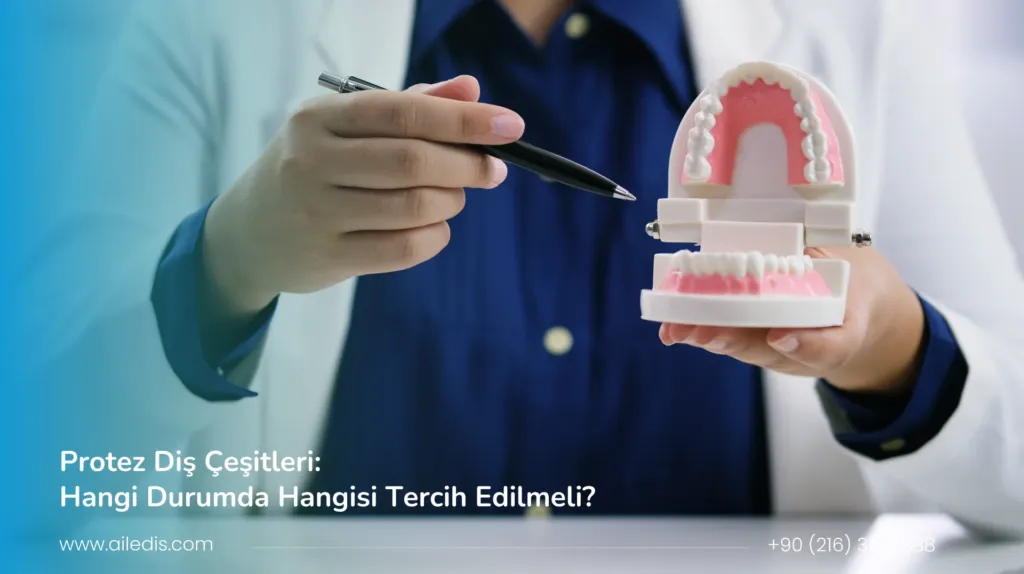Dental health is one of the most important elements of general health. Caries, fractures or structural damage to the teeth can negatively affect not only the aesthetic appearance, but also basic functions such as chewing and speaking. In these cases, it is one of the most frequently used methods by dentists. filling treatment.
Composite Filler and Porcelain Filler, , These are the two most preferred methods for dental restoration. Composite fillings provide an aesthetic appearance close to natural tooth color; Porcelain fillings stand out with their durability and long-lasting structure.
But which type of filling is more suitable for you; The position of the tooth can vary according to the depth of the caries and aesthetic expectations.
PRIVATE FAMILY DENTAL CLINICIt offers the most suitable solutions both aesthetically and functionally in composite and porcelain filling applications. Our specialist physicians aim for a natural appearance and long-term durability by preserving the structure of the tooth.
In this article, Differences between composite and porcelain fillingWe will examine in detail its advantages, disadvantages and in which situations it should be preferred.
What is composite filling and how is it applied?
Composite filling is a material used to repair caries or damaged areas while maintaining the appearance of teeth. It consists of a mixture of materials such as acrylic and glass ionomers. This type of filling, which can be in tooth color, is very advantageous in terms of aesthetics.
The application process is usually simple. Firstly, the dentist cleans and shapes the damaged area. Then the composite material is applied in layers and hardened with special light. Finally, the surface of the fillings is smoothed and terminated.
Composite Filler Advantages
One of the biggest advantages of composite filling is its aesthetic appearance. Being able to produce in tooth color makes it possible to make a perfect fit with natural teeth. In this way, patients can easily continue their daily lives without worrying about their smiles.
In addition, composite fillings have a fast application process. These procedures, which can be done in a single session, allow patients to use their time effectively. Composite filling materials are also a suitable option for those looking for low-cost alternatives.
Composite filler disadvantages
Composite filling, although aesthetically advantageous, has some disadvantages. First of all, these fillers have a high risk of wear and discoloration over time. The fact that the teeth can differentiate from their natural color can negatively affect the aesthetic appearance in the long run.
Also, composite fillings are more susceptible to hard chewing forces. This may increase the risk of fracture or cracking, especially in the posterior teeth. In terms of long-term durability, they can lag behind materials such as porcelain.
How long does composite fill last?
The durability of the composite filling usually ranges from 5 to 10 years. This time depends on the location of the tooth, the material used and the patient’s oral care habits. Especially composite fillings on the posterior teeth are at risk of wear out over time, as they are exposed to more chewing force.
Techniques applied by dentists also affect this endurance. When done correctly, the composite padding can maintain its functionality for a long time, as well as its aesthetic appearance. However, it is important to monitor the condition with regular controls.
What is porcelain (ceramic) filling and how is it made?
Porcelain filling is a frequently preferred restoration method in dentistry. It is applied to the anterior teeth, especially due to aesthetic concerns. Porcelain material attracts attention with its natural tooth structure and is known for its longevity.
The application process is usually two-stage. First, the damaged area is cleaned and sent to the laboratory by taking measurements. The porcelain filling prepared in the laboratory environment is fixed by placing it in the patient’s mouth in the second session. High precision is required in this process.
Porcelain Filler Advantages
Porcelain fillings are aesthetically advantageous. It makes your smile more attractive by offering a very close look to the natural color of the tooth. In addition, thanks to its light-transmitting feature, it adapts between teeth.
In terms of durability, porcelain fillings stand out. It has high resistance to chewing forces and is long-lasting. The low risk of micro-leakes helps the filling stay for a long time without breaking down. Because of these features, it is preferred by many dentists.
porcelain filling disadvantages
Among the disadvantages of porcelain fillings, the most important is that the application process is long and complex. Since it is necessary to prepare in a laboratory environment, two or more sessions are usually needed. This can lead to a waste of time for patients.
In addition, porcelain filler has a very delicate structure. It is at risk of crashing or breaking due to hard food. Another problem is its cost; Porcelain fillings are generally more expensive than composite fillings, which may be why some patients are not preferred.
In which situations is porcelain filling preferred?
Porcelain filling is often preferred when large caries or when the structural integrity of the tooth is threatened. Such fillings are an ideal option for patients with aesthetic concerns, because they perfectly imitate natural tooth color.
In addition, porcelain padding can be used easily on the posterior teeth thanks to its high durability. It is a suitable choice for those who are looking for solutions that carry excessive load or for those who are looking for longer-lasting solutions.
Resistance comparison between composite and porcelain filling
Composite and porcelain fillings, are the two most preferred treatment options in both aesthetic and functional repairs. The difference between them is evident in terms of material used, application time, durability and aesthetic performance.
PRIVATE FAMILY DENTAL CLINICHe emphasizes that both types of fillings give effective results in the right case, but the needs of the patient should be carefully evaluated for long-term success.
The following table summarizes the main differences of the two types of filling:
| Feature | Composite Filler | Porcelain Filler |
| Durability | Intermediate | high level |
| Implementation time | one session | 2 Sessions (Laboratory Progressive) |
| Color Stability | Color change over time | Color is preserved for a long time |
| Breaking Risk | Low-Medium | Very low |
| aesthetic appearance | Natural, but may become dull over time | Structure closest to natural tooth appearance |
| usage | Front teeth and small fillings | Rear teeth and areas requiring high chewing force |
Resistance to Composite Filling and Porcelain Filler Chewing Loads
Composite filling, against chewing loads Moderately durable. It is generally preferred in the front teeth due to its soft and aesthetic structure. However, in contact with hard foods Micro Cracks may occur.
Porcelain filling is higher to compression resistance has Thanks to its hard structure, it lasts for a long time against chewing forces. For this reason, it is especially preferred in posterior teeth (molar). With regular checks, porcelain fillings can offer a lifespan of 10 years or more.
Composite Filler and Porcelain Filler Micro-leakage and breakage risk
Composite fillings are applied directly to the tooth and hardened by polymerization. However, in this process Micro-leaking risk visible. Over time, bacteria can leak from the edges of the filling and cause tooth decay.
Porcelain fillings are specially produced to fit the tooth perfectly. The risk of micro-leakage is very low. However, in cases of excessive chewing load or poorly aligned biting Breaking Risk may occur. Therefore, the correct bite setting is important.
Long-term color and structure stability
Composite fillings contain color pigments over time discoloration can show. External factors such as tea, coffee and cigarettes cause the filling to become dull. Long-term color preservation is difficult, especially in aesthetic areas.
If porcelain fillings Color Constancy shows a superior performance. It reflects light like natural teeth, does not stain and retains its brightness over time. This feature provides both aesthetic and long-term satisfaction.
Composite Filler and Porcelain Filler Aesthetic Appearance Comparison
Tooth filling applications not only repair caries or fractures; It also plays an important role in terms of smile aesthetics. Composite and porcelain fillings are the two most frequently preferred options in terms of aesthetic appearance and durability.
PRIVATE FAMILY DENTAL CLINICIt helps patients to make the right choice between these two methods, taking into account both functional and aesthetic needs.
Composite fillings offer a natural look because they can be prepared in tooth color; Porcelain fillings provide an aesthetically superior result in the long run with their shimmery and smooth surfaces.
Below, you can examine the two types of fillers in terms of aesthetics, application process and maintenance.
Aesthetic appearance of composite fillings
Composite fillings provide a natural appearance as they can be prepared in tooth color.
However, over time, due to environmental factors (coffee, tea, cigarettes, etc.) and insufficient oral hygiene, the surface may become dull and color tone changes may occur.
Composite fillings, which are frequently preferred for aesthetic repairs in the anterior region of the tooth, can maintain their aesthetic appearance for a long time with the right care and regular controls.
Advantages:
- It can be applied in a single session.
- It is prepared in accordance with the color of the tooth.
- Ideal for small bruises and aesthetic corrections.
Disadvantages:
- It may change color over time.
- Wear resistance is lower than porcelain fillings.
Aesthetics and color harmony in porcelain fillings
Porcelain fillings give the closest aesthetic result to natural tooth tissue thanks to its light transmittance.
With its glass-like smooth surface, it provides both a radiant and natural look.
It is resistant to discoloration and the peripheral teeth form an excellent integrity.
In addition, since the surface structure is smooth, plaque and bacterial grip is minimal.
This provides a great advantage not only in terms of aesthetics, but also in terms of long-term oral hygiene.
| Criterion | Composite Filler | Porcelain Filler |
|---|---|---|
| color match | Good, but may change over time | Excellent, lasting color stability |
| Brightness | High in the first place, may decrease over time | Stays fixed in the long run |
| smear resistance | Intermediate | high level |
| aesthetic level | Natural | Perfect |
Risk of discoloration in composite filling
Composite fillings may show color change over time because they contain organic components.
Coffee, tea, red wine and smoking can affect the surface color of the filling.
However, regular brushing, professional calculus cleaning and annual controls slow this process down.
Family dental specialist recommendation:
- Brush your teeth twice a day and use dental floss.
- Stay away from acidic drinks.
- Have a professional cleaning every 6 months.
Natural tooth appearance in porcelain filling
Porcelain fillings can exactly imitate the light transmittance of natural tooth tissue.
This feature makes them ideal for patients with high aesthetic expectation.
There is no color change over time, and its glossy surface is preserved for many years.
Thanks to its smooth structure, plaque grip is low, which both protects gum health and provides long-term hygiene.
PRIVATE FAMILY DENTAL CLINICPorcelain fillings are prepared with digital measurement technology to achieve a perfect harmony and natural appearance.
Application process in composite and porcelain fillings
Both types of fillers have different application stages.
Composite fillings can be applied by the dentist in a single session. The caries or broken part of the tooth is cleaned, the composite material is placed directly on the tooth and hardened with special light.
Porcelain fillings are completed in two sessions. In the first session, the measurement is taken, the filling is prepared in the laboratory and in the second session, the tooth is adhered to.
This method gives more advanced results in terms of precision and durability.
| Stage | Composite Filler | Porcelain Filler |
|---|---|---|
| Implementation time | one session | Two sessions (measure + gluing) |
| Preparation | direct application | Laboratory Production |
| usage time | 5–7 years | 10–15 years |
| Precision | may be short-lived | minimum |
Composite Filling Single Session Application
Composite fillings are preferred especially for minor repairs and aesthetic corrections with their fast-practical structure.
The natural tissue of the tooth is minimally abraded, which shortens both the processing time and the recovery period.
The patient can return to his daily life by completing the treatment on the same day.
This feature, Family dental clinicIt provides an important advantage for patients who want to save time.
Laboratory process in porcelain filling
Porcelain fillings are produced with high precision in a laboratory environment.
A one-to-one compatible filling is prepared in terms of aesthetics and functionality by using the measurement or digital scan data taken from the tooth.
Although this process takes a few days, the result is high in terms of both aesthetics and durability.
The filler is fixed to the tooth with special adhesives and a long-lasting restoration is obtained.
Family dental clinicIt also offers the opportunity to prepare porcelain fillings in the same day with CAD/CAM technology.
Cost and maintenance in composite and porcelain filling
Composite fillings are usually a more economical option than porcelain fillings.
It provides a cost advantage because the application process is shorter.
However, the longevity of porcelain fillings can balance the cost difference over time.
Regular dentist checks are of great importance for both types of filling.
While composite fillings may wear out or show discoloration over time, porcelain fillings require caution against breakage.
Care recommendations:
- Have a check and professional cleaning every 6 months.
- Do not break hard foods directly with teeth.
- Limit excessive heat-cold consumption.
Cost and long-term care in composite and porcelain filling
Composite fillings are usually a more economical option than porcelain fillings. The price difference is due to differences in material quality and application process. While the composite filling process can be completed with a single session, porcelain fillings require laboratory processes.
Regular checks of composite-filled teeth are important for long-term care. Color change or wear may occur over time. In porcelain fillings, the risk of breakage should be taken into account, although less maintenance is required. Proper hygiene should be provided for both options.
Causes of price difference
There are many reasons for the price difference between composite filling and porcelain filling. Firstly, the quality of the materials used and the processing process affect the costs. While porcelain fillings are produced in private laboratories, composite fillings are applied in dentistry practices.
In addition, more time and expertise is required for the preparation of porcelain fillings. In this process, the dentist’s experience also plays an important role. All these factors are among the factors that determine the cost of both fillings.
Post-filling care recommendations
Post-filling care is very important to prolong the life of the filling. For the first 24 hours, you should avoid harsh foods and acidic drinks. Pay attention to your oral hygiene; Brush your teeth regularly, but be gentle rather than direct contact with the filler.
Do not neglect the regular checkups recommended by your dentist. Thus, you can track the status of your filling and identify possible problems at an early stage. In addition, protecting your dental health by reducing sugar consumption is also an important step.
Composite and Porcelain Filling Applications in Private Family Dent
private family toothComposite and porcelain filling applications are carried out meticulously by specialist dentists. The most suitable options are determined according to the needs of the patients. Both types of fillers offer different advantages; For this reason, the patient’s condition is evaluated and the decision is made.
Our specialists make the necessary examinations to protect your dental health. Composite fillings are applied quickly, while porcelain fillings require a laboratory process. In this process, the comfort of our patients is prioritized.
Specialist Dentist Review
specialist dentistcomprehensively evaluates the oral health of patients. It conducts a detailed examination of the condition of the teeth, caries and potential problems. Performs a comprehensive analysis using x-ray images in combination with clinical examination.
This evaluation process is critical to determine which type of filler would be most suitable. The specialist dentist offers composite or porcelain filling options according to personal needs. The best solution is recommended, taking into account the general health status and lifestyle of the patient.
Selection and planning suitable for the person
Choosing a personalized fillingIt may vary according to the individual’s tooth structure, lifestyle and aesthetic expectations. Composite filling may be ideal for those looking for a less invasive method; Porcelain fillings can be preferred in terms of durability and long life. Making a detailed evaluation with your dentist will ensure that you get the best result. Both methods have advantages and disadvantages. For this reason, it is important to make the right choice, taking into account your personal needs. Acting with expert recommendations in the planning process will help you have a healthy and aesthetic smile.







Composite Filler or Porcelain Filler? Frequently Asked Questions
Is pain after filling normal?
Yes, especially with deep cavities, there may be slight sensitivity for a few days after the filling. This usually goes away quickly.
What should be done if a filling falls out?
Do not wait to have a temporary filling placed to replace a fallen filling. See your dentist as soon as possible, otherwise the decay may progress.
Is anesthesia necessary before getting a filling?
In most cases, local anesthesia is administered, ensuring the procedure is completely pain-free. Small fillings can sometimes be done without anesthesia.
Does a filling extend the life of a tooth?
Yes, it eliminates the need for extraction by preserving the decayed or broken tooth. Regular check-ups can further extend the life of the filling.
How long does it take to get fillings?
Composite fillings are usually completed in 30–45 minutes. Porcelain fillings, however, require two sessions due to the laboratory process.
Which filling lasts longer?
Porcelain fillings are more durable than composite fillings. While they can last an average of 10–15 years, composite fillings generally last 5–7 years.
Can a broken porcelain filling be repaired?
Minor cracks can be repaired, but it is usually recommended to have a new filling done. The structure of porcelain makes replacement more durable than repair.
Which filler looks more aesthetically pleasing?
Both fillings are aesthetically pleasing, but porcelain fillings provide light transmission closest to the natural structure of the tooth. Therefore, they give a natural appearance even on back teeth.







